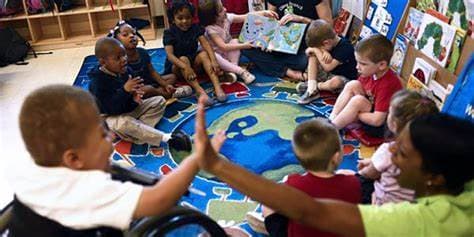Social-Emotional Learning (SEL) is crucial for fostering an inclusive classroom environment. SEL focuses on developing students’ emotional intelligence, self-awareness, and interpersonal skills, which are essential for their overall development and success.
“Integrating SEL into the classroom helps students manage their emotions, set positive goals, and establish healthy relationships,” explains Dr. Janet Collins, an SEL expert.
Teachers can incorporate SEL activities such as mindfulness exercises, conflict resolution strategies, and collaborative group work to help students develop these skills. SEL not only supports individual student growth but also promotes a positive and inclusive classroom culture.
Promoting Growth Mindset
Encouraging a growth mindset in students is another effective strategy for supporting diverse learning needs. A growth mindset is the belief that abilities and intelligence can be developed through effort and perseverance.
“Fostering a growth mindset helps students embrace challenges and view failures as opportunities for growth,” says psychologist Dr. Carol Dweck, who pioneered the concept.
Teachers can promote a growth mindset by praising effort rather than innate ability, providing constructive feedback, and encouraging students to take on challenging tasks. This approach helps students build resilience and a love for learning, regardless of their starting point.
Utilizing Peer Support Systems
Peer support systems, such as peer tutoring and buddy programs, can significantly enhance the inclusivity of a classroom. These systems allow students to support each other academically and socially, fostering a sense of community and belonging.
“Peer support systems create a collaborative learning environment where students can learn from and help one another,” explains education specialist Dr. Megan Clark.
For instance, pairing students for peer tutoring sessions can help struggling students receive additional support while reinforcing the tutor’s knowledge and skills. Buddy programs can also assist new or shy students in integrating into the classroom community.
Adapting Assessments and Evaluations
Adapting assessments to accommodate diverse learning needs is essential for accurately measuring student progress. Traditional tests may not always reflect the abilities of students with different learning styles or disabilities.
“Alternative assessments provide a more comprehensive understanding of student learning and abilities,” notes assessment expert Dr. Laura Hill.
Teachers can use various assessment methods, such as portfolios, presentations, and project-based assessments, to evaluate student learning. These methods allow students to demonstrate their knowledge and skills in ways that align with their strengths.
Encouraging Student Voice and Choice
Giving students a voice in their learning process and providing choices in how they learn and demonstrate their understanding can significantly enhance engagement and motivation.
“Empowering students with voice and choice fosters a sense of ownership and investment in their education,” says student engagement advocate Dr. Michael Patterson.
Teachers can offer choices in assignments, such as allowing students to select topics for projects or choose between different types of assessments. Providing opportunities for student input in classroom decisions, such as seating arrangements or classroom rules, also promotes a more inclusive environment.
Implementing Flexible Grouping
Flexible grouping is a dynamic approach to classroom organization that allows students to work in various group configurations based on their needs and the learning objectives.
“Flexible grouping enables teachers to tailor instruction to meet the diverse needs of their students,” explains educational consultant Dr. Susan Moore.
Teachers can create groups based on ability, interest, or learning style, and change these groups as needed. This approach ensures that all students receive appropriate support and challenges while promoting collaboration and peer learning.
Fostering a Positive Classroom Climate
A positive classroom climate is foundational to creating an inclusive learning environment. This climate is characterized by mutual respect, trust, and a sense of safety and belonging for all students.
“Creating a positive classroom climate is about building relationships and fostering a supportive community,” notes classroom management expert Dr. John Brooks.
Teachers can build a positive climate by establishing clear expectations, recognizing and celebrating student achievements, and addressing conflicts promptly and constructively. Activities that promote team-building and class cohesion also contribute to a positive atmosphere.
Leveraging Multisensory Learning Techniques
Multisensory learning techniques engage multiple senses simultaneously, enhancing comprehension and retention for all students, especially those with learning disabilities.
“Multisensory learning caters to diverse learning styles and helps students better understand and remember information,” says learning specialist Dr. Rebecca Turner.
Examples include using tactile materials for hands-on activities, incorporating visual aids like charts and videos, and utilizing auditory resources such as music or spoken word recordings. By engaging multiple senses, teachers can make lessons more accessible and engaging for all students.
Providing Professional Development on Inclusivity
Ongoing professional development focused on inclusivity equips teachers with the knowledge and skills necessary to support diverse learners effectively. Training sessions, workshops, and seminars can cover various aspects of inclusive education, from differentiation strategies to cultural competency.
“Professional development is essential for teachers to stay updated on best practices and continually improve their instructional methods,” explains professional development coordinator Dr. Karen Mitchell.
Schools can facilitate regular professional development opportunities and encourage teachers to share their experiences and insights with colleagues, fostering a collaborative learning environment among educators.
Conclusion
Creating an inclusive classroom requires a comprehensive and multifaceted approach that addresses the diverse learning needs of all students. By implementing strategies such as differentiated instruction, Universal Design for Learning, culturally responsive teaching, and leveraging technology, educators can create a supportive and engaging learning environment. Additionally, fostering a growth mindset, utilizing peer support systems, adapting assessments, and promoting student voice and choice further enhance inclusivity.
“Inclusive education is about ensuring every student has the opportunity to succeed and feel valued,” concludes Dr. Megan Clark.
As educators commit to these principles and continuously seek ways to improve their practices, they can make a profound impact on their students’ academic and personal growth, preparing them for success in an increasingly diverse and interconnected world.
